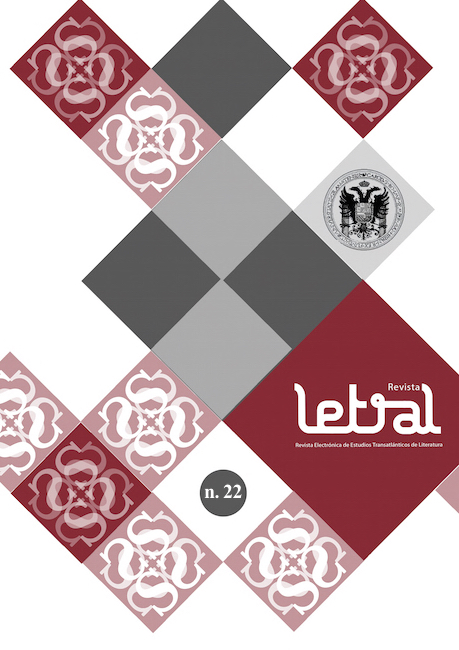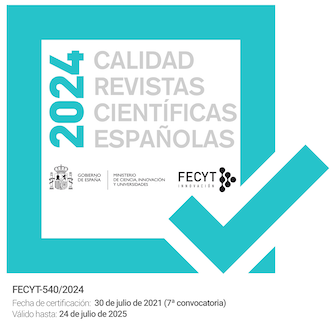Corporalidad y afecto en Umami (2015), de Laia Jufresa
DOI:
https://doi.org/10.30827/rl.v0i22.8771Palabras clave:
Corporalidad, afecto, percepción sensorial, empatía narrativa, Laia Jufresa, Umami.Resumen
El presente artículo aborda la interrelación entre lo corporal y lo afectivo en Umami (2015), la primera novela de la escritora mexicana Laia Jufresa. Se discute la riqueza de la imaginería sensorial en el texto y su rol al articular las subjetividades de los personajes. Se propone, asimismo, que el efecto de dicha dimensión sensorial, que en la novela va de la mano con lo afectivo, es invitar a una experiencia corporeizada de lectura. Si ello acrecienta la empatía narrativa por parte del lector, la novela de Jufresa complica cualquier posibilidad de un simple mimetismo afectivo entre personaje y lector mediante la disonancia dada por elementos que complejizan la textura narrativa y la dimensión afectiva del texto. Me refiero, en concreto, a una veta de suspenso que se desarrolla orgánicamente a lo largo del relato, entrelazándose con la pena y el duelo experimentados por los personajes. A partir del diálogo con un aparato teórico ecléctico, se arguye que Umami permite imaginar al sujeto –personaje y lector— como construido en la conjunción de las dimensiones corporal, afectiva y cognitiva.
Descargas
Citas
Abarca, Meredith. Voices in the Kitchen. Views of Food and the World from Working-Class Mexican and Mexican American Women. College Station, Texas A&M University Press, 2006.
Ahern, Stephen. ‘Introduction: A Feel for the Text’. Affect Theory and Literary Critical Practice, Stephen Ahern (ed.), Palgrave Studies in Affect Theory and Literary Criticism, Basingstoke, Palgrave Macmillan, 2019. Web. 1 marzo 2019.
Borges, Jorge Luis. Obra Poética 1923-1964. Buenos Aires, Emecé editores, 1964.
Brown, Bill. A Sense of Things: The Object Matter of American Literature. Chicago & London, University of Chicago Press, 2003.
Class, Monika. “Reading the Assault on the Lived Body in Hilary Mantel's Giving up the Ghost”. Embodied Narration: Illness, Death and Dying in Modern Culture, Heike Hartung (ed.), Bielefeld, transcript Verlag, 2018, pp. 227-253.
Class, Monika. “The Visceral Novel Reader and Novelized Medicine in Georgian Britain”. Literature and Medicine, nº 34.2, 2016, pp. 341-369.
Dávila, Amparo. Cuentos completos. México, D.F., FCE, 2009.
Felski, Rita. Uses of Literature. Oxford, Blackwell, 2008.
Fitzgerald, Loiuse. “‘Let’s Play Mummy’: Simulacrum Babies and Reborn Mothers”, European Journal of Cultural Studies, nº 14.1, 2011, pp. 25–39.
Freud, Sigmund. “The Uncanny”. Literary Theory: An Anthology, Julie Rivkin & Michael Ryan (eds.), 2nd ed., Oxford, Blackwell Publishing, 2004, pp. 418-429.
Goldstein, E. Bruce y James R. Brockmole. Sensation and Perception. 10a. ed., Boston, Cengage Learning, 2017.
Grosz, Elizabeth. Volatile Bodies. Toward a Corporeal Feminism. Bloomington & Indianapolis, Indiana University Press, 1994.
Highmore, Ben. “Bitter After Taste: Affect, Food, and Social Aesthetics”. The Affect Theory Reader, Melissa Gregg y Gregory J. Seigworth (eds.), Durham & London, Duke University Press, 2010, pp. 118-137.
Hogan, Patrick Colm. Affective Narratology. The Emotional Structure of Stories. Lincoln, University of Nebraska Press, 2011.
Hogan, Patrick Colm. “Affect Studies and Literary Criticism”, Oxford Research Encyclopedia of Literature, 2016, pp. 1-32. Web. 14 marzo 2019.
Hogan, Patrick Colm. Literature and Emotion. London, Routledge, 2017.
Howes, David. “Architecture of the Senses”. Sense of the City Exhibition Catalogue, Canadian Centre for Architecture, Montreal, Octubre 2005. Web. 27 enero 2019.
Jufresa, Laia. Umami. México, D.F, Literatura Random House, 2015.
Keen, Suzanne. “A Theory of Narrative Empathy”. Narrative, nº 14.3, 2006, pp. 207-236.
Keen, Suzanne. Empathy and the Novel. New York, Oxford University Press, 2007.
Keen, Suzanne. “Narrative Empathy”. The Living Handbook of Narratology, Peter Hühn (ed.), Hamburg, Hamburg University Press. Web. 27 enero 2019.
Korsmeyer, Carolyn. Making Sense of Taste: Food and Philosophy. Ithaca & London, Cornell University Press, 2014.
Korsmeyer, Carolyn y David Sutton. “The Sensory Experience of Food”. Food, Culture and Society, nº 14.4, 2011, pp. 461-475.
Littau, Karin. Theories of Reading: Books, Bodies and Bibliomania. Cambridge, Polity, 2006.
Massumi, Brian. “Notes on the Translation and Acknowledgements”, A Thousand Plateaus: Capitalism and Schizophrenia, Gilles Deleuze and Félix Guattari, traducción y prólogo Brian Massumi, London & New York, Continuum, 2004 [1987], pp. ix-xvi.
Macías García, Constantino. “La milpa”, Oikos, Instituto de Ecología UNAM, nº 17, marzo 2017, p. 5.
Marks, Laura U. The Skin of the Film. Intercultural Cinema, Embodiment and the Senses. Durham & London, Duke University Press, 2000.
Marks, Laura U. Touch. Sensuous Theory and Multisensory Media. Minneapolis & London, University of Minnesota Press, 2002.
Mascia-Lees, Frances, editora. A Companion to the Anthropology of the Body and Embodiment. Chichester, Wiley-Blackwell, 2011.
Ngai, Sianne. Ugly Feelings. Cambridge, MA & London: Harvard University Press, 2007.
Seigworth, Gregory J. y Melissa Gregg. “An Inventory of Shimmers”. The Affect Theory Reader, Melissa Gregg y Gregory J. Seigworth (eds.), Durham & London, Duke University Press, 2010, pp. 1-26.
Smith, Rachel Greenwald. Affect and American Literature in the Age of Neoliberalism. Cambridge, Cambridge University Press, 2015.
Smith, Rachel Greenwald. “Postmodernism and the Affective Turn”. Twentieth Century Literature, n.º 57.3/4, Postmodernism, Then, 2011, pp. 423-446.
Sutton, David. “Food and the Senses”. Annual Review of Anthropology, nº 39, 2010, pp. 209-223.
Toffoletti, Kim. Cyborgs and Barbie Dolls. Feminism, Popular Culture and the Posthuman Body. London & New York, IB Tauris, 2007.
Torras, Meri. “Embodiment (embodimén)”. Barbarismos queer y otras esdrújulas. R Lucas Platero, María Rosón y Esther Ortega (eds.), Barcelona, Edicions Bellaterra, 2017, pp. 161-167.
Walsh, Timothy. The Dark Matter of Words: Absence, Unknowing, and Emptiness in Literature. Carbondale, Southern Illinois University Press, 1998.
Weik von Mossner, Alexa. Affective Ecologies: Empathy, Emotion, and Environmental Narratives. Columbus, Ohio University Press, 2017.
White, Michele. “Babies Who Touch You. Reborn Dolls, Artists, and the Emotive Display of Bodies on EBay”. Political Emotions. New Agendas in Communication, Janet Staiger, Ann Cvetkovich y Ann Reynolds (eds.), New York & London, Routlege, 2010, pp. 66-89.
Descargas
Publicado
Cómo citar
Número
Sección
Licencia
Revista Letral es una publicación de acceso abierto e inmediato totalmente gratuita, tanto para quien lee como para quien publica. Los autores y las autoras no pagan ningún tipo de tasa por el proceso editorial de sus artículos. Permitimos la lectura, descarga, copia, distribución, impresión, búsqueda, enlace o reutilización con fines no comerciales de todos los trabajos publicados, siempre que se citen la autoría, la revista y el órgano editor. Recomendamos encarecidamente la difusión de los artículos en redes sociales (Facebook, Twitter, LinkedIn, etc.) y científicas (ResearchGate, Academia.edu, etc.), repositorios institucionales universitarios y otros repositorios públicos, blogs y webs personales o institucionales, Google Scholar, ORCID, ResearchID, ScopusID, etc. En cualquier caso, la propiedad intelectual de los artículos y los posibles derechos económicos derivados de ellos son exclusivamente de sus autores.














